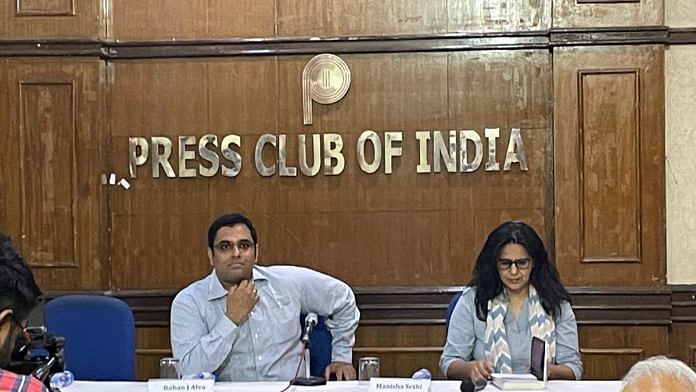New Delhi: The Indian Constitution is having its moment in the sun—no longer relegated to political science textbooks and fusty libraries. That seemed to be the consensus among participants and members of the audience during the launch of the book, A Constitution to Keep: Sedition and Free Speech in Modern India by Supreme Court lawyer Rohan J Alva.
“The law does not need a special translation anymore. SC judgements routinely show up in headlines and are being consumed by the public far more than it was, say when I was in law school,” Alva said during a discussion on his newly published book at the Press Club of India on 20 May.
More books on the subject have been released in the last couple of years, at a time when the younger generation seems to be dissecting the labyrinth that is India’s legal system. And a lot of the conversation is around the ‘sedition’ law, which condemns an individual for exciting “disaffection” towards the government.
In conversation with Manisha Sethi, author and a professor of law, Alva explained how ‘sedition’ as defined in Section 124A of the Indian Penal Code is different from ‘public order’ as mentioned in Article 19(2) of the Constitution. The latter merely allows for “reasonable restrictions”. According to Alva, words, semantics and meanings hold great importance in law. “When the constitution was drafted after attaining independence, days were spent just discussing the placement of hyphens and commas,” he said.
Also Read: Belchi wasn’t just Indira Gandhi’s moment. A legal landmark for Dalits too, new book says
Unclear definitions
Thomas Babington Macaulay, considered the master of lawmaking, is thought to be responsible for originally bringing the law to India. But Alva challenges this in his book.
“Many of his [Macaulay’s] definitions were considered clunky, such as the definition in the Indian Penal Code related to homicide. When the sedition law was brought in 1870 and included in the IPC based on his outline, there was too much confusion around what disaffection meant. Some even called it an atrocious law,” said Alva.
Over time, there were a series of debates around the workings of it, in tandem with the freedom of speech and expression. Whether sedition should be included as a reasonable restriction under Article 19(2), curbing the freedom of speech to the citizens of India, was widely debated by the advisory committee that was drafting the constitution. BN Rau’s version of the draft constitution a year later eliminated sedition.
And by 1950, the idea of sedition was completely removed as a reasonable restriction to freedom of speech, as it had no connection with State security or with the preservation of the foundations of the Indian State. However, it still persisted in the IPC.
Also Read: New book uses Nirbhaya case to explain child rights—launch event turns into a morality slugfest
Reasonable restrictions
The first amendment to the constitution, moved by Jawaharlal Nehru in 1951, altered Article 19(1)(A), which guarantees freedom of speech. ‘Public order’ was added as one of the “reasonable restrictions”.
It was observed that sedition was different from public order because the latter simply dealt with matters of public safety and local interests.
“The first amendment actually strengthened the idea that sedition was an invalid law in free India. I considered it a constitutional revolution,” says Alva.
To him, the word ‘reasonable’ stands out and differentiates it from sedition even more.
He further enumerated a stark discovery when he went over Section 66A of the Information Technology Act 2000. Although scrapped in 2015, 66A was “astoundingly similar” to the sedition law in terms of the lack of clarity, argues Alva. Section 66A enumerated punishments for sending “offensive messages” through any communication service.
A young lawyer from the audience asked Alva how he should exercise his own right to free speech.
“I was offended by an ordinance,” said the lawyer, referring to the Government of National Capital Territory of Delhi (Amendment) Ordinance 2023 that allowed the Centre to make fresh claims of power over postings and transfers in Delhi. The ordinance was promulgated on 19 May barely a week after a Constitution Bench headed by Chief Justice of India DY Chandrachud held that the Delhi government could administer civil services in the national capital.
“But as a lawyer, is my only place to fight against it in the court of law, arguing on behalf of someone else? Or can I bring myself to the streets and exercise my rights?” he asked.
Alva continued to uphold his ideological belief in the difference between sedition and public order. To him, criticism of the law did not affect public order. “There is nothing wrong with wanting to exercise your political speech. Criticism of the law was considered an act of sedition back then, but that is just not the case now,” he said.






